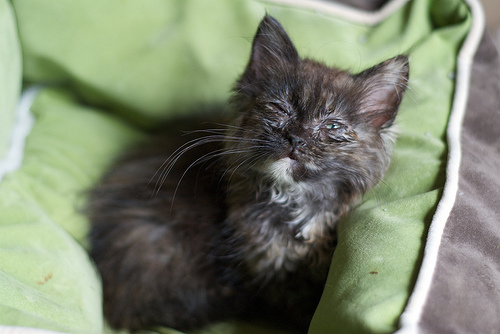Sick Dog or Cat? Steps For At Home Veterinary Care
If your pet is sick, there are several reasons why you should care for him at home. If your dog or cat is in serious distress, or has not eaten or consumed water in 24 hours, then you should first have a veterinary exam. But if you are unable to afford a veterinary exam, or you are more willing to be involved in your dog or cats care, then consider the following suggestions.
Why care for your dog or cat at home? Your home is comfortable for your pet, and free of the stress and anxiety of being in a veterinary clinic. Barking dogs, strange people, and unusual smells are not conducive to healing.
At times you can provide superior nursing care to what is offered in veterinary clinics. They are busy places, and your veterinarian can only spend so much time with your pet. You can offer a range of treatments not usually available at a veterinarian. You can give natural and alternate forms of treatment. You will often save money – in some cases, this can mean hundreds of dollars. And perhaps most importantly, you can avoid the serious side effects of many of the traditional medications.You and your pet both win. You will heal your pet at home, and in doing so you will greatly increase the bond you have with your pet. This deeper emotional connection will make your life more enjoyable and help keep your pet healthy.
Nursing Care
Comfortable Bedding
Every sick pet needs to be comfortable. Ensure that big dogs have lots of padding, especially if they have difficulty moving.
Quiet environment, but not Too quiet
All sick pets need a quiet area. Place their bed out of the main traffic area, but not so far away that they are isolated. They need regular contact.
Keep the area clean
Your pet may have difficulty getting up and going to the bathroom, and may soil himself. Change the blankets or towels frequently.
Eating
Eating problems
Most sick pets will not eat for 24 hours, and that should not be a concern. If your pet has still not eaten after 24 hours, that is a serious cause for concern – especially in cats.
There are many simple things that you can do to stimulate your pet’s appetite.
Hand feeding
The simple act of feeding with your hand – this will often work.
Warm up the food
When the food is warmer, it is more appetizing, and it is easier for your dog or cat to smell it. If it smells good, they will often eat.
Pet your pet
The simple act of stroking your pet will stimulate positive feelings in your pet and often cause them to begin eating.
If your pet has gone more than 48 hours without eating, he may need force feeding, and you have a few options. You can pick up high calorie liquid nutrition such as ‘Hills Prescription Diet a/d’ or ‘Eukanuba Maximum-Calorie’. You can also make your own high calorie food. I have included an example of a diet below.
Home Pet Nutrition Booster
1/2 cup cooked turkey or chicken
1/4 cup of whole milk
1/4 cup of rice
400 mg calcium
1 One-A-Day Multivitamin
1 tbsp flax oil
Mix this well in a blender or food processor.
Feed 1/2 to 1 cup per day to small pets, and increase proportionally. In some cases, you will have to syringe feed – give frequent, small amounts.
Drinking / Dehydration
It is of utmost importance for your pet not to become dehydrated.
The Skin
The first test for dehydration is ‘tenting’ the skin. Pinch the skin between your pet’s shoulder blades and see how quickly it springs back. It should go back in less than 5 seconds. If the skin tent is prolonged, then your pet is dehydrated.
The Eyes
Your pet’s eyes will be sunken into their head. Specifically, the eyes recede into the eye socket. It is often seen with dehydrated cats.
Capillary Refill
Your pet’s gums are the best indicator of dehydration. Lift your pet’s lips to expose the gums (pink tissue above the teeth). Place your index finger on the gums and press your finger flat to the gum. This temporarily squeezes blood in that spot out of the small blood vessels (capillaries). When you lift your finger, the blood should return in less than 2 seconds. This response will be delayed in a dehydrated pet.
Gum moisture
The gums often feel dry and tacky in a dehydrated pet. When you pull your index finger away from the gums, it should feel wet, and easily slide away. In a dehydrated pet, your finger will stick to the gums.
Possible solutions
Ice Cubes
Some dogs will readily lick ice cubes when they are dehydrated, even if they are reluctant to drink water. Float the ice in their water bowl.
Rehydration with a Syringe
Pets that are more severely dehydrated will benefit from additional electrolytes. ‘Pedialyte’ is an oral electrolyte re-hydration supplement for children. A needle-less syringe or a turkey baster works well. Insert the tip into the center of your pet’s mouth. Tilt his head back, hold his mouth closed and squirt in the fluid.
A safe rule of thumb is to give 30 ml (2 tablespoons) per 10 lbs of weight every hour.
Bathing and Cleaning
Bathing
You do not want to subject a very ill pet to unnecessary baths, but when they become fouled with vomit or diarrhea, they will feel much better after a bath.
I would advise using a mild oatmeal-based shampoo, drying well with a towel to ensure that he does not get cold, and a blow dryer.
Cleaning
Many diseases will cause discharge from the various body openings:
The Nose
Keep the nose clear of plugs or secretions. Compress the end of the nose with a warm cloth to loosen up the secretions before you try and wipe them. It helps to keep the secretions off by covering the end of the nose with Vaseline.
The Eyes
Crusts and secretions often form in the corner of the eyes. Apply a warm cloth compress to loosen the secretions and make it easier to remove. Often this is secondary to eye infections, and you may find the best result using infusions of ‘Eyebright’. This is discussed in detail under the section on Eye Infections.
The Ears
They are often infected in dogs, less commonly in cats. The easiest way to keep debris from building up is to clean the ears once weekly – one way is a homemade vinegar solution. Instill it directly into the ear canal, massage the base of the ear to allow the solution to work its way in, then wipe the excess out with a cotton ball
Gently pull the ear flap over the head and drop the vinegar solution into the lowest opening of the ear canal. Gently massage the ear area to help work the solution deeper into the ear canal. If there is enough medication in the ear, you will just begin to hear a ‘squishing’ noise as you massage.
If the ears are very inflamed, then it’s best to apply a soothing topical lotion first. Calendula and Aloe Vera are both effective in decreasing the inflammation.
Having a sick dog or cat is especially concerning, and if you are at all concerned I always urge you to first have a veterinary exam. If you lack the funds to see your veterinarian though, there are a number of things that you can do at home for your pet. You can provide nutrition in the way of force feeding and you can syringe in water to stave off dehydration. You can keep your pet comfortable with proper bathing and cleaning, ultimately helping them heal at home.
Best Wishes,
Dr Andrew Jones, DVM


my cat has sarcoma, taking cytoxan 4 days on, 3 days off, is there any kind of food that will help in reducing the tumors? thank you
My cat has had recurring ear infections since March. A lab test revealed the bacteria pasteurella was present. The vet prescribed liquid Clavamox oral antibiotic which was effective as long as I continued using it. Once I stopped, the infection returned. Eventually the vet performed ear canal ablation surgery. The surgery was considered successful but the infection returned. The only thing that seems to keep it under control is the Clavamox but I can’t see keeping him on antibiotics forever. Do you have any suggestions? Thank you.
Dr. Jones.
We follow you and your videos on YouTube for certain remedies and information.
You are an AMAZING Veterinarian.
One of our cats had a huge furball in her belly and she screamed so loud from pain we thought something was really wrong with her. She is only about 5 years old and such a great little girl. Well we followed your advice with putting Vaseline on her gums and low and behold that did the trick! It took a few days after placing it on her gums as you suggested and she was able to vomit it up.
We are so thankful to you for that advice.
GOD BLESS YOU for your GREAT WORK!
Keep up the great work.